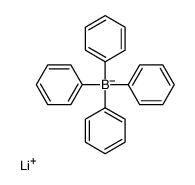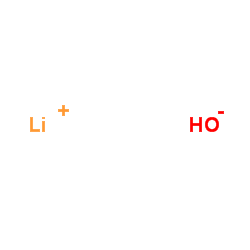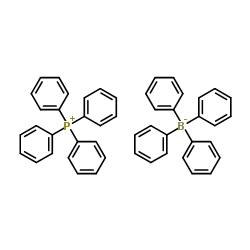lithium tetraphenylborate(1-)

lithium tetraphenylborate(1-) structure
|
Common Name | lithium tetraphenylborate(1-) | ||
|---|---|---|---|---|
| CAS Number | 14485-20-2 | Molecular Weight | 326.16800 | |
| Density | N/A | Boiling Point | N/A | |
| Molecular Formula | C24H20BLi | Melting Point | N/A | |
| MSDS | N/A | Flash Point | N/A | |
| Name | lithium,tetraphenylboranuide |
|---|---|
| Synonym | More Synonyms |
| Molecular Formula | C24H20BLi |
|---|---|
| Molecular Weight | 326.16800 |
| Exact Mass | 326.18200 |
| LogP | 3.06400 |
Synonym:Tetraphenylboron lithiu Section 2 - COMPOSITION, INFORMATION ON INGREDIENTS
Risk Phrases: 36/37/38 Section 3 - HAZARDS IDENTIFICATION EMERGENCY OVERVIEW
Irritating to eyes, respiratory system and skin. Potential Health Effects The toxicological properties of this material have not been investigated. Use appropriate procedures to prevent opportunities for direct contact with the skin or eyes and to prevent inhalation. Section 4 - FIRST AID MEASURES Eyes: Immediately flush eyes with plenty of water for at least 15 minutes, occasionally lifting the upper and lower eyelids. Skin: Flush skin with plenty of water for at least 15 minutes while removing contaminated clothing and shoes. Ingestion: Do NOT induce vomiting. If conscious and alert, rinse mouth and drink 2-4 cupfuls of milk or water. Inhalation: Remove from exposure and move to fresh air immediately. Notes to Physician: Section 5 - FIRE FIGHTING MEASURES General Information: As in any fire, wear a self-contained breathing apparatus in pressure-demand, MSHA/NIOSH (approved or equivalent), and full protective gear. During a fire, irritating and highly toxic gases may be generated by thermal decomposition or combustion. Extinguishing Media: In case of fire, use water, dry chemical, chemical foam, or alcohol-resistant foam. Section 6 - ACCIDENTAL RELEASE MEASURES General Information: Use proper personal protective equipment as indicated in Section 8. Spills/Leaks: Clean up spills immediately, observing precautions in the Protective Equipment section. Sweep up, then place into a suitable container for disposal. Section 7 - HANDLING and STORAGE Handling: Wash thoroughly after handling. Remove contaminated clothing and wash before reuse. Avoid contact with eyes, skin, and clothing. Avoid ingestion and inhalation. Storage: Store in a cool, dry place. Keep container closed when not in use. Section 8 - EXPOSURE CONTROLS, PERSONAL PROTECTION Engineering Controls: Use adequate general or local exhaust ventilation to keep airborne concentrations below the permissible exposure limits. Use process enclosure, local exhaust ventilation, or other engineering controls to control airborne levels. Exposure Limits CAS# 14485-20-2: Personal Protective Equipment Eyes: Not available. Skin: Wear appropriate protective gloves and clothing to prevent skin exposure. Clothing: Wear appropriate protective clothing to minimize contact with skin. Respirators: Wear a NIOSH/MSHA or European Standard EN 149 approved full-facepiece airline respirator in the positive pressure mode with emergency escape provisions. Section 9 - PHYSICAL AND CHEMICAL PROPERTIES Physical State: Not available. Color: Not available. Odor: Not available. pH: Not available. Vapor Pressure: Not available. Viscosity: Not available. Boiling Point: Not available. Freezing/Melting Point: 0 deg C Autoignition Temperature: Not available. Flash Point: Not available. Explosion Limits, lower: Not available. Explosion Limits, upper: Not available. Decomposition Temperature: Solubility in water: Specific Gravity/Density: Molecular Formula: C24H20BLi Molecular Weight: 326.16 Section 10 - STABILITY AND REACTIVITY Chemical Stability: Stable under normal temperatures and pressures. Conditions to Avoid: Strong oxidants. Incompatibilities with Other Materials: Not available. Hazardous Decomposition Products: Irritating and toxic fumes and gases. Hazardous Polymerization: Has not been reported. Section 11 - TOXICOLOGICAL INFORMATION RTECS#: CAS# 14485-20-2 unlisted. LD50/LC50: Not available. Carcinogenicity: LITHIUM TETRAPHENYLBORATE - Not listed by ACGIH, IARC, or NTP. Section 12 - ECOLOGICAL INFORMATION Section 13 - DISPOSAL CONSIDERATIONS Dispose of in a manner consistent with federal, state, and local regulations. Section 14 - TRANSPORT INFORMATION IATA Not regulated as a hazardous material. IMO Not regulated as a hazardous material. RID/ADR Not regulated as a hazardous material. Section 15 - REGULATORY INFORMATION European/International Regulations European Labeling in Accordance with EC Directives Hazard Symbols: XI Risk Phrases: R 36/37/38 Irritating to eyes, respiratory system and skin. Safety Phrases: S 24/25 Avoid contact with skin and eyes. WGK (Water Danger/Protection) CAS# 14485-20-2: No information available. Canada CAS# 14485-20-2 is listed on Canada's NDSL List. CAS# 14485-20-2 is not listed on Canada's Ingredient Disclosure List. US FEDERAL TSCA CAS# 14485-20-2 is listed on the TSCA inventory. SECTION 16 - ADDITIONAL INFORMATION N/A |
| HS Code | 2931900090 |
|---|
|
~% 
lithium tetraph... CAS#:14485-20-2 |
| Literature: Haddenham, Dustin; Pasumansky, Lubov; DeSoto, Jamie; Eagon, Scott; Singaram, Bakthan Journal of Organic Chemistry, 2009 , vol. 74, # 5 p. 1964 - 1970 |
|
~% 
lithium tetraph... CAS#:14485-20-2 |
| Literature: Wittig, G.; Keicher, G.; Rueckert, A.; Raff, P. Liebigs Annalen der Chemie, 1949 , vol. 563, p. 110 - 126 |
|
~% 
lithium tetraph... CAS#:14485-20-2 |
| Literature: Grassberger,M.A.; Koester,R. Angewandte Chemie, 1969 , vol. 81, p. 261 |
|
~% 
lithium tetraph... CAS#:14485-20-2 |
| Literature: Gmelin Handbook: Li: SVol., 150, page 489 - 491 |
|
~% 
lithium tetraph... CAS#:14485-20-2 |
| Literature: Revzin, G. E.; Vulikh, A. I.; Arkhipov, S. M.; Zamedyanskaya Metody Poluch. Khim. Reaktivov Prep., 1967 , # 16 p. 33 - 47 Full Text Show Details Gmelin Handbook: B: B-Verb.8, 11.2.4.1, page 173 - 175 |
|
~% 
lithium tetraph... CAS#:14485-20-2 |
| Literature: Reynard, K. E.; Sherman, R. E.; Smith, H. D.; Hohnstedt, L. F. Inorganic Syntheses, 1973 , vol. 14, p. 52 - 55 Full Text Show Details Gmelin Handbook: B: B-Verb.8, 11.2.4.1, page 173 - 175 |
|
~% 
lithium tetraph... CAS#:14485-20-2 |
| Literature: Gmelin Handbook: Li: SVol., 150, page 489 - 491 |
| HS Code | 2931900090 |
|---|---|
| Summary | 2931900090. other organo-inorganic compounds. VAT:17.0%. Tax rebate rate:13.0%. Supervision conditions:AB(certificate of inspection for goods inward,certificate of inspection for goods outward). MFN tariff:6.5%. General tariff:30.0% |
| EINECS 238-486-3 |
| Tetraphenyl-borsaeure,Lithium-Salz |
| Lithium tetraphenylborate |
| tetraphenyl-boric acid,lithium-salt |






 CAS#:1310-65-2
CAS#:1310-65-2 CAS#:15525-15-2
CAS#:15525-15-2